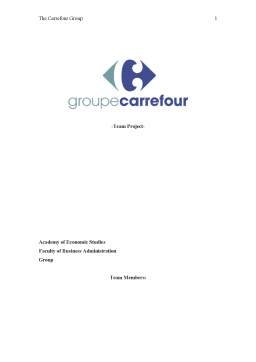Cuprins
- I. Short presentation: financial figures, history, development 3
- I.1.The Carrefour group: a world leader in distribution 3
- I.2. History and development 3
- II. Mission, Values, Strategy 5
- II.1. Mission 5
- II.2. Seven values, seven common points of reference: 6
- II.3. Strategy 7
- III. Customer Relationship Management 8
- III.1 International loyalty programs 8
- Low prices – its top priority 8
- Stores with a strong sense of the market 9
- A Commitment to quality 9
- House brands–the key to building customer loyalty 10
- Enhancing customer loyalty tools 10
- Increasing the number of services offered 11
- III.2. Loyalty programs in Romania 11
- III.3. Customer Relationship Management Solutions: Coheris CRM 13
- The best of CRM 13
- Software that evolves as your business processes change 13
- Functionality 13
- IV. Scope and Competition 14
- IV.1. World Wide 14
- Scope 14
- Competition 18
- IV.2. National level 21
- Invasion of new hypermarkets 21
- Scope: What does it take to earn a new costumer? 22
- Competition: What makes the difference? Personalized Brands 22
- V. Criticism 23
Extras din proiect
I. Short presentation: financial figures, history, development
I.1.The Carrefour group: a world leader in distribution
Over the past 40 years, the Carrefour group has grown to become one of the world’s leading distribution groups. The world’s second-largest retailer and the largest in Europe, the group currently operates four main grocery store formats: hypermarkets, supermarkets, hard discount and convenience stores. The Carrefour group currently has over 12,000 stores, either company-operated or franchises, counting more than 436000 employees.
A pioneering entrant in countries such as Brazil (1975) and China (1995), the group currently operates in three major markets: Europe, Latin America and Asia. With a presence in 29 countries, over 52% of group turnover (93.614 billion euros) derives from outside France. The group sees strong potential for further international growth in the future, particularly in such large national markets as China, Brazil, Indonesia, Poland and Turkey.
I.2. History and development
Two French businessmen, Marcel Fournier and Louis Deforrey, entered the market in the 1950's. Stores were evolving from small, family run operations to supermarkets. The pair had experience in department store retailing and wanted to expand their business interests by starting a supermarket. Fournier and Defforey had reason to think big in regard to French food retailing. Department stores were thriving. Large assortments of merchandise in one location appealed to consumers. Free service (self service shopping with carts or baskets) had been widely accepted. Department store goods were pricey, however, and store locations in the city center were not convenient for food shopping. There had to be a better solution for food shopping in France. The first Carrefour store opened on June 3, 1957, in suburban Annecy near a crossroads (carrefour in French). Today it is the smallest Carrefour location in the world.
Fournier and Defforey saw opportunity to incorporate multiple food shopping preferences under one roof. Their new venture, named Carrefour, was an expanded supermarket featuring a wide assortment of merchandise, fast service, and low prices. The store was an instant success, selling out of all merchandise in four days. Carrefour, which means crossroads or marketplace, signaled a new direction in French retailing. Success realized by the first Carrefour store prompted the owners to open a second store in 1963. The store was expansive by 1960's standards. It offered a wide assortment of food and non-food merchandise and on-site parking. This large scale store ushered in the era of the hypermarket. Carrefour's business continued to increase throughout the 1960's and 70's.
Small business, long supported and nurtured by the French government, began to experience extreme competition from hypermarkets during the late 1970's and 1980's. The French government imposed expansion limitations on hypermarkets as a protectionary measure for small business. Limited growth opportunities resulted and fierce competition erupted among food retailers. Carrefour and other large French retailers were forced to seek other avenues of territorial expansion. French retailing became fragmented and Carrefour's stock went public for the first time. These combined push factors signaled a new direction for Carrefour and the internationalization of French food retailing. Carrefour was successful in its early internationalization efforts. Brazil, Argentina, and Spain were easy and profitable points of entry. Acquisitions and joint ventures dominated the firm's international retailing activity. French hypermarkets, lead by Carrefour, comprised over 75% of all foreign joint ventures in food retailing during the period 1970-1990.
Hypermarkets matured in France during the 1980's. Carrefour strategically reduced the size of some stores and formed retail partnerships to diversify product offerings. Private label products were introduced in 1976 as a low price alternative. Carrefour's name and brand image quickly ranked them as France's private label leader. Carrefour was France's leading hypermarket retailer in 1988 with 65 domestic stores. Internationally Carrefour's reach extended to ten countries. International efforts continued to thrive with 115 locations in Europe and South America.
Success in multiple foreign markets encouraged Carrefour to introduce its hypermarket format to the United States. In 1988, a new 330,000 square foot store was opened in suburban Philadelphia. Carrefour failed to do its homework, however, using a low-key French advertising approach to introduce the store. The response was lack luster. A second store opened in a nearby New Jersey suburb in 1991. It produced an equally dismal showing. Carrefour learned a costly lesson in the US venture. What works in France does not necessarily translate well to other countries.
Preview document
Conținut arhivă zip
- The Carrefour Group.doc




































